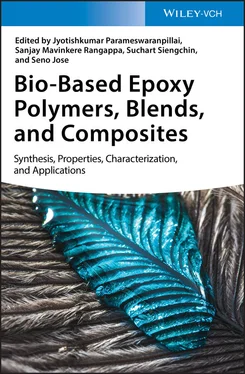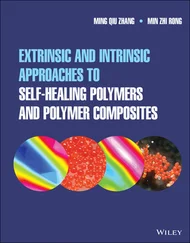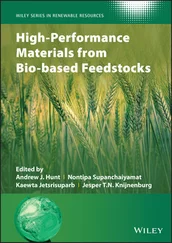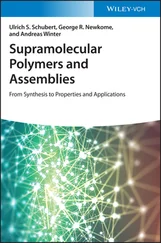315 312
316 313
317 314
318 315
319 316
320 317
321 318
322 319
323 320
324 321
325 323
326 324
327 325
328 326
329 327
330 328
331 329
332 330
333 331
334 332
335 333
336 334
337 335
338 336
339 337
340 338
341 339
342 340
343 341
344 342
345 343
346 344
347 345
348 346
349 347
350 348
351 349
352 350
353 351
354 352
355 353
356 354
357 355
358 356
359 357
360 358
361 359
362 360
363 361
364 362
365 363
366 364
367 365
368 366
369 367
370 368
371 369
372 370
373 371
374 372
375 373
376 374
377 375
378 376
379 377
380 378
381 379
Bio-Based Epoxy Polymers, Blends, and Composites
Synthesis, Properties, Characterization, and Applications
Edited by
Jyotishkumar Parameswaranpillai
Sanjay Mavinkere Rangappa
Suchart Siengchin
Seno Jose

Editors
Dr. Jyotishkumar Parameswaranpillai
King Mongkut's University of Technology North Bangkok
Center of Innovation in Design and Engineering for Manufacturing
1518 Pracharaj 1
Wongsawang Road, Bangsue
10800 Bangkok
Thailand
Dr. Sanjay Mavinkere Rangappa
King Mongkut's University of Technology North Bangkok
Department of Mechanical and Process Engineering
1518 Pracharaj 1
Wongsawang Road, Bangsue
10800 Bangkok
Thailand
Prof. Dr.-Ing.habil. Suchart Siengchin
King Mongkut's University of Technology North Bangkok
Department of Mechanical and Process Engineering
1518 Pracharaj 1
Wongsawang Road, Bangsue
10800 Bangkok
Thailand
Dr. Seno Jose
Government College Kottayam
Department of Chemistry
Nattakom P O
Kottayam
686013 Kerala
India
Cover
Cover Image: © 985 Bilder/Pixabay
All books published by Wiley‐VCHare carefully produced. Nevertheless, authors, editors, and publisher do not warrant the information contained in these books, including this book, to be free of errors. Readers are advised to keep in mind that statements, data, illustrations, procedural details or other items may inadvertently be inaccurate.
Library of Congress Card No.:applied for
British Library Cataloguing‐in‐Publication Data
A catalogue record for this book is available from the British Library.
Bibliographic information published by the Deutsche Nationalbibliothek
The Deutsche Nationalbibliothek lists this publication in the Deutsche Nationalbibliografie; detailed bibliographic data are available on the Internet at < http://dnb.d-nb.de>.
© 2021 WILEY‐VCH GmbH, Boschstr. 12, 69469 Weinheim, Germany
All rights reserved (including those of translation into other languages). No part of this book may be reproduced in any form – by photoprinting, microfilm, or any other means – nor transmitted or translated into a machine language without written permission from the publishers. Registered names, trademarks, etc. used in this book, even when not specifically marked as such, are not to be considered unprotected by law.
Print ISBN:978‐3‐527‐34648‐6
ePDF ISBN:978‐3‐527‐82359‐8
ePub ISBN:978‐3‐527‐82361‐1
oBook ISBN:978‐3‐527‐82360‐4
Editors are honored to dedicate this book to their family members and friends. Editors would like to thank King Mongkut's University of Technology North Bangkok (KMUTNB), Thailand for the support through Grant No. KMUTNB-BasicR-64-16.
Epoxy polymers are thermosetting polymers widely used in construction and building, automobile, aerospace, and marine industries. However, traditional epoxy systems are nonbiodegradable and cannot be recycled. The plastic waste is generating at an alarming rate and only 9% is recycled, and the remaining 91% is either landfilled or dumped in the natural environment. Moreover, plastic waste accumulation in the seawater, especially in the Pacific Ocean, is increasing at an alarming rate. Therefore, researchers and scientists are concentrating to develop biodegradable polymers. One of the inventions in this area is the production of bioepoxy resins from different plant sources. A surge in the production of bioepoxy resins was observed in the past decade. The polymer manufacturers (Sicomin, Gougeon Brothers, Wessex Resins, Bitrez, etc.) are now producing bioepoxy resins. Generally, bioepoxy resins are brittle, which limits their application in advanced composite industries. Studies have shown that the incorporation of fillers/fibers can significantly enhance the thermomechanical, electrical, and other physical properties of the bioepoxy composites. The high acceptance level of bioepoxy resins in automobile, aerospace, construction, and marine industries all across the world is expected to increase the production of bioepoxy resins in the coming years.
The research in the field of bioepoxy resins and their blends and composites are flourishing. This leads to an upsurge in the number of publications. However, no books have been published in the area of bioepoxy resins. Therefore, we believe that it is important to edit a book on “Bio‐Based Epoxy Polymers, Blends, and Composites: Synthesis, Properties, Characterization, and Applications.” We hope that the present book will benefit scientists, engineers, academic staff, and students working in the area of bio‐based epoxy polymers, blends, and composites.
This book consists of 12 chapters that describe “Bio‐Based Epoxy Polymers, Blends, and Composites: Synthesis, Properties, Characterization, and Applications.” The chapter “Synthesis of Bioepoxy Resins” summarizes the synthesis of fully bio‐based epoxy resins, their properties, and potential uses. The chapter “Natural/Synthetic Fiber‐Reinforced Bioepoxy Composites” focuses on the different bioepoxy resins and natural/synthetic fiber‐reinforced bioepoxy composites, their mechanical properties, and applications. The chapter “Polymer Blends Based on Bioepoxy Polymers” reviews the preparation of bio‐based epoxy blends for various applications. The chapter “Cure Kinetics of Bioepoxy Polymers, Their Blends, and Composites” emphasizes the importance of kinetics studies of the bioepoxy/hardener reaction. The chapter “Rheology of Bioepoxy Polymers, Their Blends, and Composites” discusses the role of rheological studies on the processing of the bioepoxy composites. The chapter “Dynamical Mechanical Thermal Analysis of Bioepoxy Polymers, Their Blends, and Composites” describes the viscoelastic properties of bioepoxy blends and composites. The chapter “Mechanical Properties of Bioepoxy Polymers, Their Blends, and Composites” discusses the factors influencing the mechanical aspects of bioepoxy composites. The chapter “Bioepoxy Polymer, Blends, and Composites Derived Utilitarian Electrical, Magnetic, and Optical Properties” reviews the electrical, electronic, magnetic, and optical properties of bioepoxy systems. The chapter “Spectroscopy and Other Miscellanies Techniques for the Characterization of Bioepoxy Polymers, Their Blends, and Composites” gives an overview of the characterization of bioepoxy systems using various techniques such as Fourier transform infrared spectroscopy, nuclear magnetic resonance spectroscopy, differential scanning calorimetry, and thermogravimetric analysis. The chapter “Flame Retardancy of Bioepoxy Polymers, Their Blends, and Composites” highlights the recent developments in flame‐retardant bio‐based epoxy resins. The chapter “Water Sorption and Solvent Sorption of Bioepoxy Polymers, Their Blends, and Composites” focuses on the water absorption properties of bioepoxy systems. The chapter “Bio‐Based Epoxy: Applications in Mendable and Reprocessable Thermosets, Thermosetting Foams, and Pressure‐Sensitive Adhesives” give an overview of the recent developments in self‐healing bioepoxy systems and bio‐based epoxy foams.
Читать дальше













